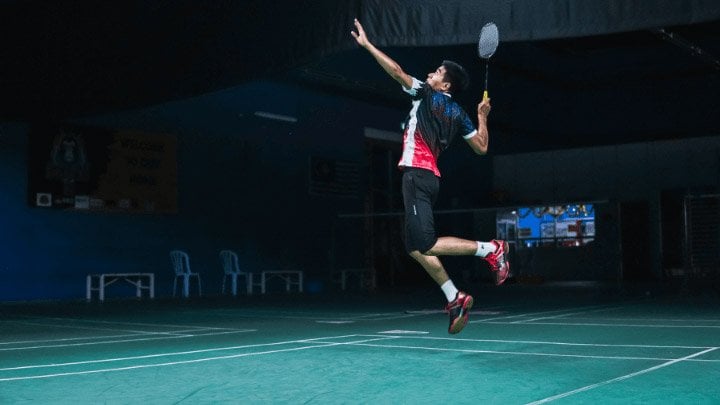
We include products we think are useful for our readers. If you buy through links on this page, we may earn a small commission. Here’s our process.
There are three types of shuttlecocks to choose from that vary depending on a wide variety of factors, from durability to ease of use. So which shuttlecock is best for you? Here is a helpful table with our ratings on the most important factors (the higher the number, the better).
| Durability | Speed | Shuttle flight | Predictable trajectory | Cost | Ease of use | Total | |
| Feather shuttlecock | 3 | 9 | 9 | 9 | 6 | 7 | 43/60 |
| Plastic/Synthetic shuttlecock | 8 | 7 | 4 | 5 | 8 | 7 | 39/60 |
| Hybrid shuttlecock | 6 | 8 | 7 | 7 | 7 | 7 | 42/60 |
In this guide, we will be covering the following headings to help you decide which shuttlecock is best for you.
Let’s jump into it.
Types of Shuttlecock
Shuttlecocks are available in three types:
- Feather Shuttlecocks
- Plastic/Synthetic Shuttlecocks
- Hybrid Shuttlecocks.
Feather Shuttlecocks
These shuttlecocks are made from duck or goose feathers, with one feather shuttlecock containing no less than 16 feathers.
After being plucked from a live animal, the feathers (16 or so) are embedded into a round cork base, before being secured in place with a sorting machine. See how a shuttlecock is created here on YouTube.
Benefits of Feather Shuttlecocks
Feather shuttlecocks offer excellent shuttle flight, are much easier to control than their counterparts, and provide a predictable trajectory.

Their added weight gives more ‘feedback’ to the players, making it easier to hit court-crossing clears and unplayable smashes.
These reasons explain why feather shuttlecocks are preferred by intermediate to professional-level players who are at or near the top of their game.
Drawbacks of Feather Shuttlecocks
On the flip side, these shuttlecocks aren’t quite durable. Poor timing and technique can break the feathers before you know it.
It isn’t uncommon for feather shuttlecocks to last only one game, sometimes even less. Worse, their flight becomes compromised even as one feather gets damaged. Also, while a plastic shuttlecock costs less than $1 on average, one premium feather shuttlecock can cost as much as $5.
High initial cost and low durability are why feather shuttlecocks aren’t recommended for newbie badminton players or those with poor technique.
Here is the best feathered shuttlecock you can buy on Amazon.
Plastic/Synthetic Shuttlecocks
Plastic shuttlecocks are usually made from nylon material, offer a fast flight and are much more durable than feather shuttlecocks.
More often than not, their fast flight results in a fast-paced game that requires less control or touch-play from the players.
Benefits of Plastic Shuttlecocks
Since they are made of synthetic materials, plastic shuttlecocks are much cheaper and more durable than feather shuttlecocks.
It isn’t uncommon for plastic shuttlecocks to last for 100s of games, making them a more cost-effective option than their feathered alternative.
Both these characteristics make these shuttlecocks a must-have for amateur players as well as for a casual playing session on the court.
Drawbacks of Plastic Shuttlecocks
There are two reasons amateur players ditch these shuttlecocks once their level goes up: less consistent speed and unpredictable trajectory.
Furthermore, you’ll have to hit the plastic shuttlecock harder for your clears/smashes to be effective, increasing the risk of an injury.
Which explains the saying: you stroke a feather, you punch a plastic.
Here is the best plastic shuttlecock you can buy on Amazon.
Hybrid Shuttlecocks
Hybrid shuttlecocks are a combination of feather and plastic.
The frame of the shuttle and the cork material is synthetic, whereas the end feathers are goose/duck feathers.
These shuttlecocks aren’t as common as their plastic or feather rivals. So, you may have to search quite a lot to find one of these near you.
Benefits of Hybrid Shuttlecocks
Hybrid shuttlecocks offer two benefits vis-a-vis their feathered rivals: they’re much more durable and cost less due to lower manufacturing costs.
Compared with plastic shuttlecocks, hybrids offer a more consistent trajectory and provide better feedback to the player, reducing the risk of injury.
Drawbacks of Hybrid Shuttlecocks
The main reason hybrid shuttlecocks aren’t the primary choice of professional players is that they have an inferior flight path compared to a premium full-feather shuttlecock.
Furthermore, while their price is no longer less than their feathered rivals, these shuttlecocks still cost more than the plastic ones.
Pro Tip: If you love playing with feather shuttlecocks but cannot afford paying their asking price, go for hybrid shuttlecocks. They strike the sweet spot between plastic and feather in terms of cost, aerodynamics, and response.
Here is the best hybrid shuttlecock you can buy on Amazon.
Speed of the Shuttlecock
Based on their speed, badminton shuttlecocks are classified into five categories ranging between 75 and 79.
The higher the number, the faster the speed of the shuttlecock and the longer the distance it will cover when hit with a standard degree of force.
Speeds 75 and 76 are common in India and other countries with long summers, whereas speeds 77 and 78 are popular in Europe and countries with long and harsh winters.
Which Factors Affect the Speed of the Shuttlecock?
The speed of a shuttlecock is affected by three factors:
- Temperature. The lower the temperature, the slower the shuttlecock will move across the air.
- Humidity. When there is high humidity, the shuttlecock will travel slowly because of a large percentage of water particles in the air.
- Altitude. The higher the altitude of the area where you’re playing badminton, the slower the shuttlecock’s speed due to added air pressure.
How to Decide Which Shuttlecock Speed is Right for You?
- If you live in an area with long winters and short summers (Europe, Canada, Russia, etc.), a shuttlecock with a fast speed rating (77-79) might suit you more.
- If you live in an area with long summers (Asia, parts of America, Australia, etc.), go for a shuttlecock with a slow to moderate (75-77) speed rating.
Price and Durability
People who have never played the game find it hard to understand that the most expensive shuttlecocks (feathered) are generally the least durable.
On the other end are plastic shuttlecocks, which usually cost a pittance up front but can last 100s of games while requiring minimal post-match care.
So, if you want a shuttlecock that costs less up-front and is ultra-durable, plastic shuttlecocks are a no-brainer, provided you have no complaints about their unpredictable trajectory or inconsistent speed.
Conversely, if you want to take your game to the next level and are willing to pay (relatively) big bucks for the same, feather shuttlecocks are your best bet.






